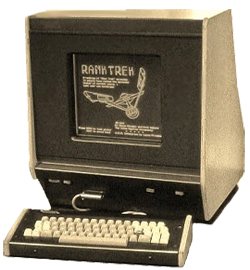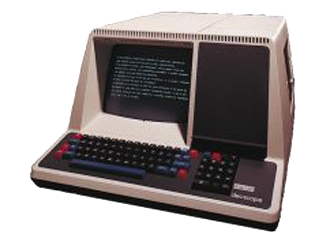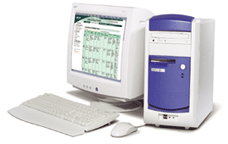✸ Timelines
Use REIN Arrow Tabs for timelines
REIN Arrow tabs is an excellent way to display a timeline with additional information about each time period.
Contributions to eLearning
1960's
PLATO
 The University of Illinois engineers developed the Illinois Automatic Computer (ILLIAC) system which eventually evolved into the first computer based training (CBT) platform. The evolving product became known as PLATO or Programmed Logic for Automated Teaching Operations. Donald Bitzer, a professor of electrical engineering at the university, was the principle engineer responsible for its development. The primary function of PLATO was to provide a rich environment in which educators and trainers could create and deliver quality interactive courseware to students in classrooms, homes, and offices without the presence of an instructor. One of PLATO's greatest features was its online community empowered by its communication capabilities.
The University of Illinois engineers developed the Illinois Automatic Computer (ILLIAC) system which eventually evolved into the first computer based training (CBT) platform. The evolving product became known as PLATO or Programmed Logic for Automated Teaching Operations. Donald Bitzer, a professor of electrical engineering at the university, was the principle engineer responsible for its development. The primary function of PLATO was to provide a rich environment in which educators and trainers could create and deliver quality interactive courseware to students in classrooms, homes, and offices without the presence of an instructor. One of PLATO's greatest features was its online community empowered by its communication capabilities.1970's
The Internet
 On Oct 29, 1969, Charley Kline at UCLA sent the first packets of data over a network of four computers called ARPANet (Advanced Research Projects Agency Network). The 1970′s would prove to be the formative years for the early internet. ARPANet added several more nodes. Other mini-networks began to emerge throughout the United States and Europe. By the end of the 1970s, a computer scientist named Vinton Cerf developed a way for all of the computers on all of the world’s mini-networks to communicate with one another. He called his invention "Transmission Control Protocol," or TCP. He later added an additional protocol, known as "Internet Protocol." These protocols became known as TCP/IP. This group of protocols eventually allowed connections between distant computers in a virtual space. The term "internet" then became commonplace.
On Oct 29, 1969, Charley Kline at UCLA sent the first packets of data over a network of four computers called ARPANet (Advanced Research Projects Agency Network). The 1970′s would prove to be the formative years for the early internet. ARPANet added several more nodes. Other mini-networks began to emerge throughout the United States and Europe. By the end of the 1970s, a computer scientist named Vinton Cerf developed a way for all of the computers on all of the world’s mini-networks to communicate with one another. He called his invention "Transmission Control Protocol," or TCP. He later added an additional protocol, known as "Internet Protocol." These protocols became known as TCP/IP. This group of protocols eventually allowed connections between distant computers in a virtual space. The term "internet" then became commonplace.1980's
The PC
 While computers sold in piece parts had been available to enthusiasts during the 1970's, it wasn't until the 1980's that consumer-friendly computer systems sat atop home office desks. Time magazine called 1982 "The Year of the Computer" as the computer industry had finally evolved to the personal computing level. Steve Jobs and Steve Wozniak, founders of Apple, released the Apple III business computer in 1980 but without great success. Meanwhile, IBM began working on its first personal computer, simply called PC. It was officially released in 1981. The IBM PC was popular for its open architecture. Since it contained no necessary proprietary parts, the IBM PC could be "cloned" by other manufacturers and inexpensively produced. Apple acknowledged the competition and took on the challenge to improve its version of the personal computer. The personal computing revolution began and would never look back.
While computers sold in piece parts had been available to enthusiasts during the 1970's, it wasn't until the 1980's that consumer-friendly computer systems sat atop home office desks. Time magazine called 1982 "The Year of the Computer" as the computer industry had finally evolved to the personal computing level. Steve Jobs and Steve Wozniak, founders of Apple, released the Apple III business computer in 1980 but without great success. Meanwhile, IBM began working on its first personal computer, simply called PC. It was officially released in 1981. The IBM PC was popular for its open architecture. Since it contained no necessary proprietary parts, the IBM PC could be "cloned" by other manufacturers and inexpensively produced. Apple acknowledged the competition and took on the challenge to improve its version of the personal computer. The personal computing revolution began and would never look back.1990's
 Educational Software
Educational SoftwareMajor developments in educational software in the 1990's were made possible by advances in computer hardware and increased popularity of the internet. Multimedia graphics and audio were increasingly used in educational programs. CD-ROMs became the preferred method for content delivery. Several digital encyclopedias were released as multimedia applications on CD-ROMs. With the spread of the internet, new methods of educational software emerged with an increasing number of resources available online. The terms "courseware" and "learning management system" were coined as teaching and learning kits were packaged for use on a personal computer.
2000's
Learning Management Systems and SCORM
 In the 2000's, the World Wide Web began to possess websites that went beyond static pages of text and graphics. The web began to emerge as a platform where software applications could be built online as opposed to being designed for the desktop. Different learning and content management applications became widely available. Moodle was developed and eventually became a popular choice among educational institutions seeking to create online campuses. Sharable Content Object Reference Model (SCORM) emerged as a collection of standards and specifications for web-based learning of which is commonly housed within a learning management system. The concept of "distance education" began to take on a much different arrangement.
In the 2000's, the World Wide Web began to possess websites that went beyond static pages of text and graphics. The web began to emerge as a platform where software applications could be built online as opposed to being designed for the desktop. Different learning and content management applications became widely available. Moodle was developed and eventually became a popular choice among educational institutions seeking to create online campuses. Sharable Content Object Reference Model (SCORM) emerged as a collection of standards and specifications for web-based learning of which is commonly housed within a learning management system. The concept of "distance education" began to take on a much different arrangement.2010's
Web 2.0 and eLearning
 In the present decade of the 2010's, the online learning environment is more interactive and collaborative with the advent of Web 2.0 and social media technologies. Technologies, such as blogs, wikis, podcasts, games, webinars, and social networks are revolutionizing learning in ways never experienced before. Students are no longer limited to newsgroups and emails for exchange of information. Web technologies are allowing learning tasks to be simplified. They are empowering students to more readily become producers, designers and writers of their own work. Learning opportunities are more personal and motivational. The collective intelligence of online communities is putting information at learners' fingertips. Social networking tools makes it easier to connect and collaborate with the right people at the right time - the exchanges spontaneously empower learning and the generated content becomes accessible to others seeking information. The technologies and services available on the internet today support unique needs of learners on their own personal learning journey.
In the present decade of the 2010's, the online learning environment is more interactive and collaborative with the advent of Web 2.0 and social media technologies. Technologies, such as blogs, wikis, podcasts, games, webinars, and social networks are revolutionizing learning in ways never experienced before. Students are no longer limited to newsgroups and emails for exchange of information. Web technologies are allowing learning tasks to be simplified. They are empowering students to more readily become producers, designers and writers of their own work. Learning opportunities are more personal and motivational. The collective intelligence of online communities is putting information at learners' fingertips. Social networking tools makes it easier to connect and collaborate with the right people at the right time - the exchanges spontaneously empower learning and the generated content becomes accessible to others seeking information. The technologies and services available on the internet today support unique needs of learners on their own personal learning journey.